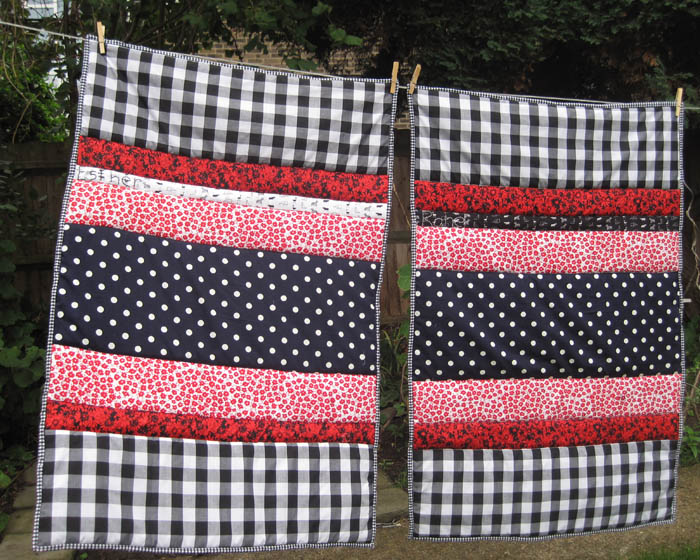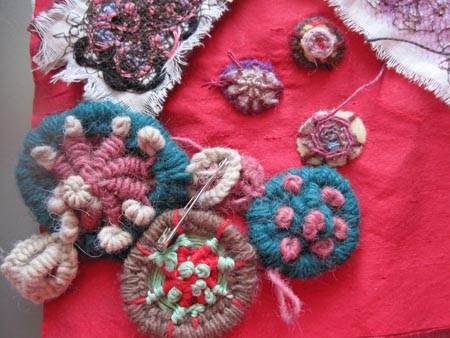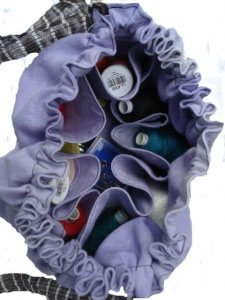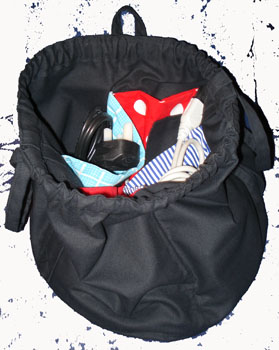I had a spare cushion inner and so decided to use up some strips of fabric from previous projects.
So here is the result a strippy front and a stars and strips back.
 Another baby enters the world and so another quilt or “cuddly” must be made. This baby has a sister who isn’t yet two and who didn’t receive a “being born” present from me so I decided that it was only fair to make them each a quilt.
Another baby enters the world and so another quilt or “cuddly” must be made. This baby has a sister who isn’t yet two and who didn’t receive a “being born” present from me so I decided that it was only fair to make them each a quilt.
My inspiration came from the new baby’s name. She is called Rahel which is the Hebrew for ewe or female sheep. Way back when we first took TLM (the Loom Monkey) up to Durham to start his education, I purchased some sheep fabric at Durham market so it seemed appropriate to take the scissors to it for the reverse of baby Rahel’s “cuddly”. Big sister is Esther, which in Hebrew means star and a lunchtime outing to my nearest to work fabric emporium found me the happy purchaser of a metre of red material scattered with white stars. 
The fronts of the quilts are almost identical. Towards the upper edge of each I have inserted a narrow strip of fabric covered with tiny sketched animals. The strips are from the two different colourways of a fabric. One is white and one is black. The binding on each quilt is tiny black and white gingham, a favourite binding fabric of mine and as a final touch I embroidered each of the girls’ names on that narrow animal strip. My reasoning behing all this is that each cuddly is similar enough so that there are no arguments about which belongs to which but the girls will be able to know that it is their own quilt from both the back and the front.
Their father is not due back from paternity leave for quite a while so I had to squidge both quilts into a parcel and run off to the post office in my lunch break.
What if you were going to be away from home for Christmas? What could you take with you to ensure that your home-from-home would not seem bare in the festive season?
Voila – a non-invasive Christmas decoration!
This is the prototype. Materials used here were a tatty old red paper napkin, a piece of scrap paper (for the leaves of unidentified species) and a large berry cut from a piece of sky in a magazine picture. As you can see, in the prototype, the side of the folded large triangle has been stapled, as were the leaves and berry.
I will now try a version made from red and green felt, with the side sewn closed and the leaves and berries sewn on with a couple of stitches. Or what about using 4 red fabric triangles with quilt batting/wadding sandwiched in between?
If my pictures and words don’t make sense then think about a photo held in an album by those triangular photo-corners.
 I really should have been getting ready for work but instead I was off reading blogs as I usually do while I eat my breakfast each morning. It sets me up for the day. I pop in to see all my old friends and then often get sidetracked and find someone new and decide they are worthy of being added to my bookmark bar at the top of my web browser.
I really should have been getting ready for work but instead I was off reading blogs as I usually do while I eat my breakfast each morning. It sets me up for the day. I pop in to see all my old friends and then often get sidetracked and find someone new and decide they are worthy of being added to my bookmark bar at the top of my web browser.
This morning a wandering path led me to LAVENDERHOUSE and her posting called CIRCLES OF COLOUR which reminded me of something I started to play around with after a visit to the Knitting and Stitching Show at Alexandra Palace in 2007. Yes I did type 2007 intentionally. I went to one of those 15 minute classes. The pieceof red silk is from the class as are those three spiderweb circles stitched to the red silk. Everyone else there seemed to be an expert at embroidery so I was the obligatory slow one in the corner. Luckily now that I am allegedly grownup I don’t care what anyone else thinks and I just get on with enjoying the moment and taking away from I can. in this case that something was the inspiration of DORSET BUTTONS and so I played around (see bottom left of pic) with something that owes its technique to dorset buttons, crochet, tatting and probably other crafts as well.
The results have remained pinned to the red silk on the wall in J’s old bedroom, where I keep my sewing machine, forgotten until I read Ms LavenderHouse’s blog this morning. Those circles were made with short craps of yarn lying in or around the bin so very much in keeping with what Ms LavenderHouse was told by Madeline Millingtonnot …”not to bother with expensive yarn as cheap yarn in rainbow colours gives a really good result.”
I couldn’t bear to part with real money for a camera case so ran this up from a few scraps. I forgot how much things shrink when quilted. Although this isn’t actually quilted because there are no lines of stitching, other than seams, holding it all together, it is padded with a DOUBLE layer of wadding so what was a very respectable flap has magically shrunk to a “just about” flap. The closure is half a hair elastic and a bead.
I’ve spent most of today making a N U M P bag (Network cable, Usb cable, Mouse, Power cable)
for G.
He saw my drawstring sewing things bag and decided that he would like a bag, made to a similar design,
to contain cables and other bits and pieces for his laptop. This cable-organising bag could then be
slung in his rucksack without everything ending up as a rat’s nest.
When opened completely flat, the sewing bag is a very large circle.


The N U M P bag, however, is made as a cylinder. It looks a little like a small fabric bucket.
The exterior fabric is black cotton duck. Black chosen to be masculine and the cotton duck because it is a sturdy fabric.
Inside the N U M P bag there are 4 pockets/dividers, each made from a different fabric. A really
organised person will always put a particular cable back in a particular pocket, therefore making it
easy to know where each cable is. Each of the pockets has a smaller pocket on the outside, two of
them wide and two skinnier ones which can be used for pens, pencils etc.
The bag has a circular bottom and a drawstring closure. There is a sturdy grab handle on each side,
and a loop so that the bag can be hung up on a hook.

I live not far from Hounslow, Middlesex. It is a mini-mini-mini Southall. By that I mean that it has a high Asian population and consequently a good few shops full of Asian goodies. One of these shops sells fabric, much of it with a great bling factor and even better than that there is usually some very cheap fabric to be had. The downside is that I never really NEED any such fabric but of course I can’t resist a rummage in the remnant bin or the purchase of “just one metre” of this and that. So it was that a few years ago I acquired this purple fabric.

If you look at the bottom of the photo you will see the front of the material. It really is a bit too much for me to think of anything to use it for and so it has languished in various bags, piles and heaps since it came home with me.
For a while I have been considering that the back of the fabric would be more useable even though those gold squiggles show through in places. My scissors first cut into two pieces that I sandwiched together with some wadding to make a cover for a notebook. I also sewed in two bookmarks made from wrapped yarn. I used a length of red yarn and machine wrapped it with red bobbin thread and blue top thread.
My second piece of purple playfulness was the unfinished clutch bag in the middle. I bought some bondaweb with the idea that being double-sided I could fuse it between two layers of the fabric and it would also give it some substance. I don’t know what I was thinking of because of course the bondaweb is so gossamer-like that once the two protective layers are removed there was no substance left. I probably should have abandoned the project there and then but I’m not like that. I enjoy messing around. So I picked up my second attempt at wrapped thread that had turned out to be what I grandly call “antique gold”. I then began to sew strips of this wrapped thread all over the cut out & sandwiched fabric pieces (one body +flap piece and two gussets). Soon they began to act rather like a corset and when I sewed the pieces together into the bag shape it was more or less self-supporting. Now I think that I will I have to line it somehow and I’ll probably use a double or triple length of the remaining wrapped thread for a strap (even though clutch bags don’t need a strap).
Moving on to the SOCK SILLINESS …

I have my father’s big toes. They seem to have a life of their own and though I don’t ever feel them at it, I know that they wriggle and jiggle all day inside my shoes. How else would I have one giant hole in each toe of nearly all of my socks. Yes, I do know how to darn and I do darn although most of my socks are a cotton mix and don’t accept a lot of darning or in my case, major reconstruction, as well as wool socks do. A week or two ago I was being all New Yearish and I emptied and sorted my sock drawer. I had no idea how many pairs of socks I had because quite honestly I ran out of fingers and toes (big or small) to count them on. I took a deep breath and decided to throw out all those socks that had darns on the darns or were in urgent need of such. The pile was mountainous and I just couldn’t bear to throw them out. I had several pairs of spotty, dotty socks and many with stripes. I have a weakness for both. So .. I cut off the damaged toes, the heels (which are the most three-dimensional part of the sock) and the cuffs. This resulted in two “tubes” per sock and I cut down each down the length resulting in a flat pirce of sock fabric. Then in a very haphazard way I zig-zagged the pieces together. Now what on earth have I ended up with …. a squilt? And what on earth do I do with this “squilt”?
Finally … on the left …. two more pieces of the fabric, right bright sides together. The flower’s centre made from a green foil wrapper from a chocolate (“borrowed” from the Loom Monkey’s magpie stash of “useful things”) and the orange petals machine embroidered. Finally I stitched a decorative machine-embroidered border around the edge of the piece sandwiching the two pieces of fabric together.
An idea of how to make a circular drawstring sewing bag
I thought I’d have another go at making a drawstring sewing bag and this time take a couple of photos to explain what I mean.
The basic requirements for this little bag are:
. 2 lined circles, one bigger than the other,
. cord or ribbon for the drawstring
. 2 large beads or buttons or some extra fabric to sew on the ends of the drawstrings
The circles have to be quite a bit larger than I imagined. I suggest drawing around a dinner plate for the SMALLER circle and one inch outside the dinner plate for the larger (outside) circle.
1. You will need to cut 2 of each of the 2 circles so you will end up with 4 circles, 2 big and 2 slightly smaller.
2. Sew all around the SMALLEST circles (right sides together) with approx a 1/4 inch seam EXCEPT FOR A GAP OF ABOUT 3 inches that you will need to turn the circle inside out. Turn this small circle inside out, press and then top stitch near the outside edge carefully closing the opening by neatly tucking the seam allowances inside. Put aside.
3. Sew the 2 LARGEST circles right sides together. you will need to leave approx a 4 inch gap for turning AND ALSO 2 one-inch gaps, opposite each other to use to thread the drawstrings through.
Turn this LARGE circle inside out and press. Top stitch around edge, EXCEPT for 2 one-inch gaps using the topstitching to neatly close the 4-inch turning gap.
4. Fold the SMALL circle in half and iron to press. Fold in half again & press with iron, and fold in half one more time and press again. Open up carefully and you should have folds that divide the circle into 8 sections. Using tailors chalk or ordinary blackboard chalk draw over these folds so that your circle looks like a cake cut into 8. (see first photo at top of page). Find a small circle (e.g a glass) to draw around in the centre of this circle (see above). This will look like the centre of a flower with 8 petals around it.
5. Place the SMALL circle on top of the LARGE circle equally (see photo above). Place a pin in the middle. Carefully pin in between each line so that you will be able to sew along both sides of each line.
6.Starting at the outside of the small circle, sew down the right-hand side of the chalk line till you meet the centre drawn circle, sew along the curve of this centre circle till you meet the next line. Sew along the nearest side of the next chalk line (towards the outside of the circle of fabric) and then back down alongside it until you meet the centre circle again. Sew along that section of curve and up one side of the next chalk line etc etc until you finally arrive back at where you started. ALL THIS STITCHING WILL SHOW THROUGH ONTO THE OUTSIDE OF YOUR BAG. These lines of stitching make eight small interior pockets for reels of thread etc.
7. Back on the largest circle, sew a second line of stitching one-inch inside your outside line of stitching (do not leave any gaps in this stitching.
8. With a safety pin, thread a long drawstring (longer than the circumference of your circle) in through one gap, all way around the circle and back out where it entered. Starting at the OPPOSITE gap, thread another long drawstring through the other gap, all around the casing and back out where it entered. You need to knot the paired ends of drawstrings and either tie a large bead or button through and knot securely so that they don’t disappear into the gaps or, do as I did and, sew each pair of ribbon ends into a piece of doubled-over fabric and stitch quite a few times to secure the ribbon inside the fabric. On reflection it would have been neater to make triangular-shaped “ends” to sew the drawstring/ribbon into.
I’m quite pleased with this bag apart from the fact that the inner circle shouldn’t have been so much smaller than the outer circle.Next time I will make them with probably only one-inch in difference between the two circles.
Somehow I should be able to make a circular pincushion that is permanently attached to the “flower centre” inside the bag.
It also needs an attached needle-case and attached small scissors holster.